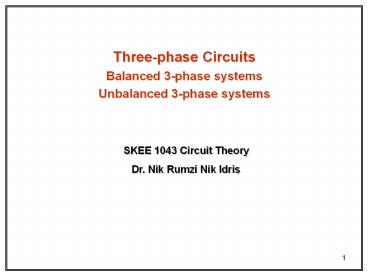Three-phase Circuits - PowerPoint PPT Presentation
1 / 8
Title:
Three-phase Circuits
Description:
Three-phase Circuits Balanced 3-phase systems Unbalanced 3-phase systems SKEE 1043 Circuit Theory Dr. Nik Rumzi Nik Idris * * Balanced 3-phase systems POWER ... – PowerPoint PPT presentation
Number of Views:282
Avg rating:3.0/5.0
Title: Three-phase Circuits
1
Three-phase Circuits Balanced 3-phase
systems Unbalanced 3-phase systems
SKEE 1043 Circuit Theory
Dr. Nik Rumzi Nik Idris
2
Balanced 3-phase systems
POWER CALCULATION
Instantaneous power
Phase voltage of Y connected load with Z?? ? per
phase
Phase current, lagging by ?
Total instantaneous power p vANia vBNib
vCNic
Which can be re-written as
3
Balanced 3-phase systems
POWER CALCULATION
Instantaneous power
- Instantaneous power is NON PULSATING
- Smoother energy conversion for electrical machine
in 3-phase system
- True for delta (?) connected load too
4
Balanced 3-phase systems
POWER CALCULATION
Complex, apparent, active, and reactive
Phase voltage
Phase current
(rms)
(rms)
The complex power per phase
Total complex power
For Y connection,
and
Apparent power is as before, i.e.
5
Balanced 3-phase systems
POWER CALCULATION
Power measurement using a wattmeter
wattmeter is an instrument used for measuring the
average power.
Equivalent Circuit with load
The basic structure
If v(t) Vmcos (?t ?v) and i(t) Imcos (?t
?i)
then the wattmeter will measure the average
power
Reading on wattmeter ?
6
Balanced 3-phase systems
POWER CALCULATION
Power measurement using a wattmeter
wattmeter is an instrument used for measuring the
average power.
7
Balanced 3-phase systems
POWER CALCULATION
3-phase power measurement using wattmeters
two-wattmeter method
In order to measure average power in 3-phase
system ONLY 2 wattmeters are needed
Reading by wattmeter1,
Reading by wattmeter2,
8
Balanced 3-phase systems
POWER CALCULATION
Reading by wattmeter1,
Reading by wattmeter2,
IT CAN BE SHOWN
- This is also true for a ? connected load as well
- This is also true if the load is unbalanced (ONLY
for P1P2) - Two-wattmeter method CANNOT be used for a
3-phase, 4 wire system UNLESS the neutral current
0 - P1P2 ? resistive load, P2 gt P1 ? inductive load,
P2 lt P1 ? capacitive load

